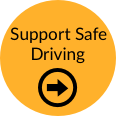Transportation
Berkeley is connected to the Bay Area by way of several public transportation options. Bay Area Rapid Transit (BART) has three stations in Berkeley and AC Transit, the bus line for the county, has 155 bus lines throughout the region. Currently, the city is working to improve transportation options with strategic plans that address barriers to walkability and transit safety. There need to be additional resources for addressing driving safety and improved collaboration between transportation, technology, and aging organizations in the county to ensure that the public's needs are met across neighborhoods and all modes of transit.
Age Friendly Resources
Public
Nonprofit
Private
Transit Map
With three BART stations and major AC Transit bus lines, most of Berkeley is well connected by public transportation. However, residents who live in the Berkeley hills have less frequent buses and not all station stops throughout the city are covered or well lit.
Bicycle Boulevards help make cyclists and pedestrians safer. Plans for additional improvements are underway.
A new ferry boat, Tideline, connects the Berkeley Marina to downtown San Francisco for commuters.
Community Survey Results
One of the main reasons Berkeley was rated positively by survey respondents as a place to age was walkability. However, sidewalk disrepair and traffic safety are issues raised by many residents. While Berkeley has made an effort to be accessible (curb cuts, etc.), trees often cause sidewalks to become uneven and some survey respondents also reported feeling unsafe crossing the street. Most people who responded to the survey said they drive to get around town, and highlighted parking as a problem. Many people thought driver education for seniors would be an important resource to have.
According to focus groups conducted by the Berkeley Continuum:
Participants felt that the City’s taxi voucher system is useful but is too limited by the number of times it can be used and the the purposes for which it can be used. In addition, many people did not know that vouchers were available. Ride sharing apps can be helpful, but they are still too expensive for many people to use regularly. Participants said they want public transit to be more frequent and more flexible.
Take Aways
Infrastructure and Policy: Many survey respondents felt that one of Berkeley's best traits is its walkability. However, sidewalk disrepair and pedestrian safety concerns can be a barrier. The Bicycle Boulevards and some new protected bike lanes are a safety improvement, but there is still more work to do.
Equity and Inclusion: Social activities, volunteer opportunities, and jobs are important, but without thoughtful infrastructure and transit programs that help seniors get where they need to go, these resources will not be utilized to their fullest extent. BART and AC Transit help connect Berkeley to the rest of the Bay Area, but issues like the "last mile," not having benches at station stops, and inadequate lighting can be a problem for some older people and prevent them from using these services.
Information: Even with abundant public transportation options, many people want to maintain the freedom of driving, and want to do so safely. Many people are interested in safe driving refresher courses, but there are limited local options for these courses. Stigma may be an issue and classes should be advertised carefully to prevent promoting stereotypes and to make sure people feel comfortable attending.

























